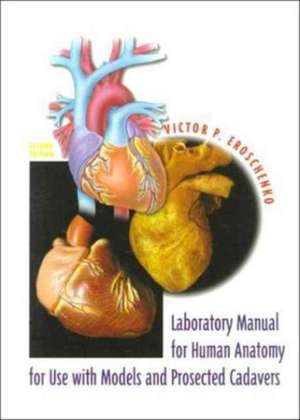Laboratory Manual for Human Anatomy with Cadavers
Autor Victor P. Eroschenko, Wami Medical Programen Limba Engleză Paperback – 31 dec 1996
Preț: 1031.21 lei
Preț vechi: 1085.48 lei
-5% Nou
Puncte Express: 1547
Preț estimativ în valută:
197.35€ • 203.87$ • 164.24£
197.35€ • 203.87$ • 164.24£
Carte disponibilă
Livrare economică 04-18 martie
Livrare express 18-22 februarie pentru 63.25 lei
Preluare comenzi: 021 569.72.76
Specificații
ISBN-13: 9780673995582
ISBN-10: 0673995585
Pagini: 448
Dimensiuni: 203 x 269 x 28 mm
Greutate: 1.16 kg
Ediția:Nouă
Editura: Pearson
Locul publicării:San Francisco, United States
ISBN-10: 0673995585
Pagini: 448
Dimensiuni: 203 x 269 x 28 mm
Greutate: 1.16 kg
Ediția:Nouă
Editura: Pearson
Locul publicării:San Francisco, United States
Descriere
Designed for beginning anatomy students working with prosected human cadavers or models, this manual is built around a series of detailed diagrams suitable for coloring. Each chapter starts with a list of specific objectives for the exercises that follow, and then features a description section where anatomical structures are introduced, defined, described, identified, and then referenced to the accompanying illustrations and figures. Finally, an identification section provides instructions for identifying lists of specific structures, first on models and charts, then on the prepared human cadaver. Each chapter ends with interactive review exercises, new to this edition.
Cuprins
I. ORGANIZATION OF THE HUMAN BODY.
1. Anatomical Terminology.
II. THE SKELETAL SYSTEM.
2. The Skull.
3. The Vertebrae and Rib Cage.
4. The Pectoral Girdle and Upper Extremity.
5. The Pelvic Girdle and Lower Extremity.
III. THE MUSCULAR SYSTEM.
6. Introduction: Joints and Muscles.
7. Muscles of the Pectoral Girdle and Upper Extremity.
8. Muscles of the Pelvic Girdle and Lower Extremity.
9. Muscles of the Thorax, Abdomen, and Pelvic Floor.
IV. THE NERVOUS SYSTEM.
10. The Brain.
11. The Spinal Cord.
12. The Cranial and Spinal Nerves.
13. The Endocrine System.
V. REGULATION AND MAINTENANCE OF THE HUMAN BODY.
14. The Heart.
15. The Major Arteries.
16. The Major Veins.
17. The Respiratory System.
18. The Digestive System.
19. The Urinary System.
VI. THE CONTINUITY OF HUMAN LIFE.
20. The Male Reproductive System.
21. The Female Reproductive System.
1. Anatomical Terminology.
II. THE SKELETAL SYSTEM.
2. The Skull.
3. The Vertebrae and Rib Cage.
4. The Pectoral Girdle and Upper Extremity.
5. The Pelvic Girdle and Lower Extremity.
III. THE MUSCULAR SYSTEM.
6. Introduction: Joints and Muscles.
7. Muscles of the Pectoral Girdle and Upper Extremity.
8. Muscles of the Pelvic Girdle and Lower Extremity.
9. Muscles of the Thorax, Abdomen, and Pelvic Floor.
IV. THE NERVOUS SYSTEM.
10. The Brain.
11. The Spinal Cord.
12. The Cranial and Spinal Nerves.
13. The Endocrine System.
V. REGULATION AND MAINTENANCE OF THE HUMAN BODY.
14. The Heart.
15. The Major Arteries.
16. The Major Veins.
17. The Respiratory System.
18. The Digestive System.
19. The Urinary System.
VI. THE CONTINUITY OF HUMAN LIFE.
20. The Male Reproductive System.
21. The Female Reproductive System.
Notă biografică
Victor P. Eroschenko completed both his undergraduate and graduate degrees at the University of California at Davis. He received his Bachelor of Arts degree in Zoology in 1961. Following graduation, he enlisted in the U.S. Army and spent the next three years in Germany. Eroschenko returned to the university in 1968 and received a Master of Science in Anatomy in 1970. In 1973, he was awarded the Ph.D. degree in Anatomy. That same summer, he accepted a faculty position at the University of Idaho in Moscow, Idaho to teach anatomical sciences to both medical students and undergraduate students. Since 1973, Eroschenko has been team-teaching Human Gross Anatomy and Medical Histology to freshman medical students in the WAMI Medical Program. He also teaches a one-semester course in Human Anatomy and Physiology to University of Idaho undergraduate students that major in Allied Health Sciences.
Eroschenko's research interests lie in the area of Reproductive Toxicology. During his academic career, he has authored or co-authored over 40 scientific papers that were published in refereed national and international journals. He is also the author of the Laboratory Manual for Human Anatomy for use with Models and Prosected Cadavers, Second Edition. He was also the editor of the 6th edition of DiFiore's Atlas of Normal Histology, and is presently the author of the Seventh and Eighth Editions of DiFiore's Atlas of Histology with Functional Correlations. Eroschenko has just completed an interactive CD-ROM disk on Human Histology, which should be published in the near future.
Eroschenko's research interests lie in the area of Reproductive Toxicology. During his academic career, he has authored or co-authored over 40 scientific papers that were published in refereed national and international journals. He is also the author of the Laboratory Manual for Human Anatomy for use with Models and Prosected Cadavers, Second Edition. He was also the editor of the 6th edition of DiFiore's Atlas of Normal Histology, and is presently the author of the Seventh and Eighth Editions of DiFiore's Atlas of Histology with Functional Correlations. Eroschenko has just completed an interactive CD-ROM disk on Human Histology, which should be published in the near future.
Caracteristici
- Each chapter begins with a list of specific objectives and then features a description section where anatomical structures are introduced, defined, described, identified, and referenced to accompanying illustrations and figures.
- An identification section provides instructions for identifying lists of specific structures, first on models and charts, then on the prepared human cadaver.
- Each chapter ends with interactive review exercises, new to this edition.








